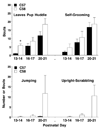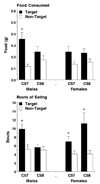Social deficits, stereotypy and early emergence of repetitive behavior in the C58/J inbred mouse strain
- PMID: 19941908
- PMCID: PMC2822076
- DOI: 10.1016/j.bbr.2009.11.031
Social deficits, stereotypy and early emergence of repetitive behavior in the C58/J inbred mouse strain
Abstract
Mouse lines with behavioral phenotypes relevant to symptoms in neurodevelopmental disorders may provide models to test hypotheses about disease etiology and to evaluate potential treatments. The present studies were designed to confirm and expand earlier work on the intriguing behavioral profile of the C58/J inbred strain, including low social approach and aberrant repetitive movements. Additional tests were selected to reflect aspects of autism, a severe neurodevelopmental disorder characterized by emergence of symptoms early in life, higher prevalence in males, social deficits and abnormal repetitive behavior. Mice from the C57BL/6J inbred strain, which has a similar genetic lineage and physical appearance to C58/J, served as a comparison group. Our results revealed that C58/J mice display elevated activity levels by postnatal day 6, which persist into adulthood. Despite normal olfactory ability, young adult male C58/J mice showed deficits in social approach in the three-chambered choice assay and failed to demonstrate social transmission of food preference. In contrast, female C58/J mice performed similarly to female C57BL/6J mice in both social tests. C58/J mice of both sexes demonstrated abnormal repetitive behaviors, displaying excessive jumping and back flipping in both social and non-social situations. These stereotypies were clearly evident in C58/J pups by postnatal days 20-21, and were also observed in C58/J dams during a test for maternal behavior. Overall, the strain profile for C58/J, including spontaneously developing motor stereotypies emerging early in the developmental trajectory, and social deficits primarily in males, models multiple components of the autism phenotype.
Copyright 2009 Elsevier B.V. All rights reserved.
Figures





Similar articles
-
Repetitive behavior profile and supersensitivity to amphetamine in the C58/J mouse model of autism.Behav Brain Res. 2014 Feb 1;259:200-14. doi: 10.1016/j.bbr.2013.10.052. Epub 2013 Nov 8. Behav Brain Res. 2014. PMID: 24211371 Free PMC article.
-
Social approach and repetitive behavior in eleven inbred mouse strains.Behav Brain Res. 2008 Aug 5;191(1):118-29. doi: 10.1016/j.bbr.2008.03.015. Epub 2008 Mar 21. Behav Brain Res. 2008. PMID: 18440079 Free PMC article.
-
Novel object exploration in the C58/J mouse model of autistic-like behavior.Behav Brain Res. 2015 Apr 1;282:54-60. doi: 10.1016/j.bbr.2014.12.030. Epub 2014 Dec 19. Behav Brain Res. 2015. PMID: 25532914
-
Further characterization of repetitive behavior in C58 mice: developmental trajectory and effects of environmental enrichment.Behav Brain Res. 2012 Dec 1;235(2):143-9. doi: 10.1016/j.bbr.2012.07.041. Epub 2012 Aug 9. Behav Brain Res. 2012. PMID: 22963990 Free PMC article.
-
Mouse behavioral assays relevant to the symptoms of autism.Brain Pathol. 2007 Oct;17(4):448-59. doi: 10.1111/j.1750-3639.2007.00096.x. Brain Pathol. 2007. PMID: 17919130 Free PMC article. Review.
Cited by
-
Autism-relevant social abnormalities and cognitive deficits in engrailed-2 knockout mice.PLoS One. 2012;7(7):e40914. doi: 10.1371/journal.pone.0040914. Epub 2012 Jul 19. PLoS One. 2012. PMID: 22829897 Free PMC article.
-
Comprehensive neurocognitive endophenotyping strategies for mouse models of genetic disorders.Prog Neurobiol. 2012 Feb;96(2):220-41. doi: 10.1016/j.pneurobio.2011.12.001. Epub 2012 Jan 13. Prog Neurobiol. 2012. PMID: 22266125 Free PMC article. Review.
-
Translational animal models of autism and neurodevelopmental disorders.Dialogues Clin Neurosci. 2012 Sep;14(3):293-305. doi: 10.31887/DCNS.2012.14.3/jcrawley. Dialogues Clin Neurosci. 2012. PMID: 23226954 Free PMC article. Review.
-
Translational Mouse Models of Autism: Advancing Toward Pharmacological Therapeutics.Curr Top Behav Neurosci. 2016;28:1-52. doi: 10.1007/7854_2015_5003. Curr Top Behav Neurosci. 2016. PMID: 27305922 Free PMC article. Review.
-
Preweaning sensorimotor deficits and adolescent hypersociability in Grin1 knockdown mice.Dev Neurosci. 2012;34(2-3):159-73. doi: 10.1159/000337984. Epub 2012 May 8. Dev Neurosci. 2012. PMID: 22571986 Free PMC article.
References
Publication types
MeSH terms
Grants and funding
LinkOut - more resources
Full Text Sources
Other Literature Sources
Medical
Molecular Biology Databases

